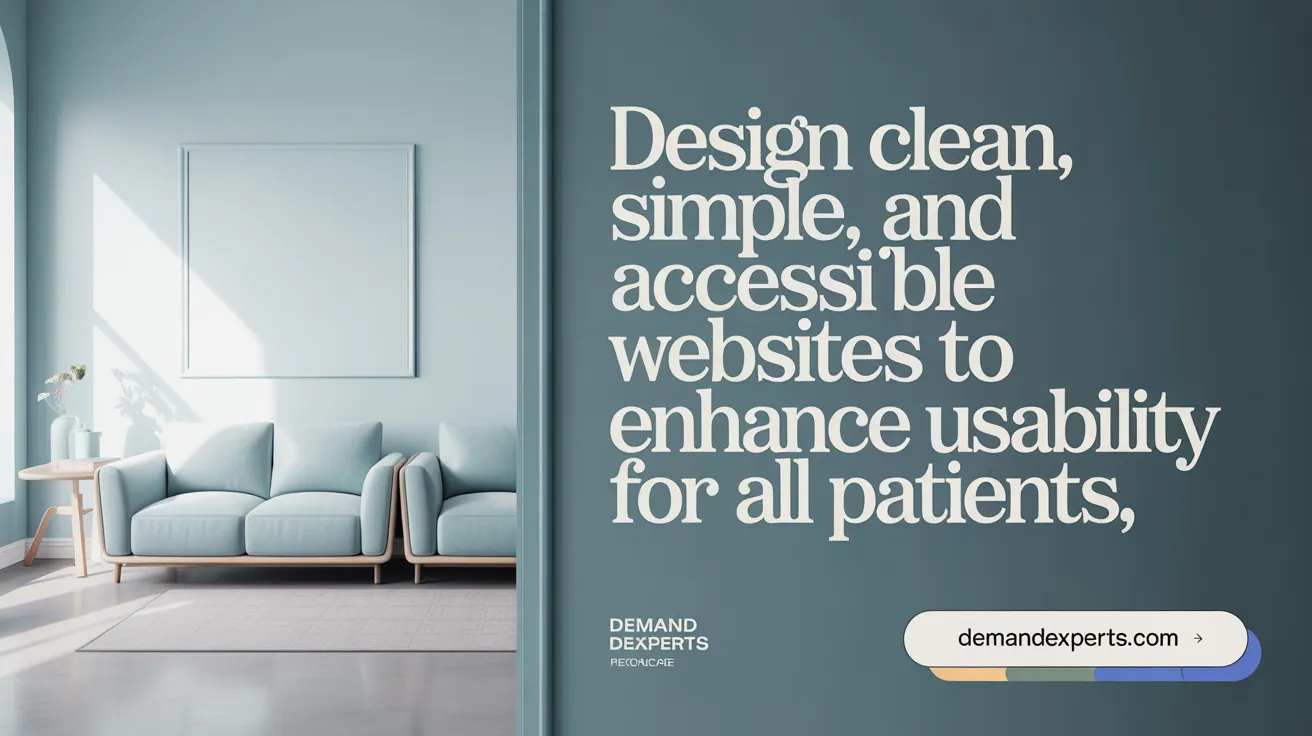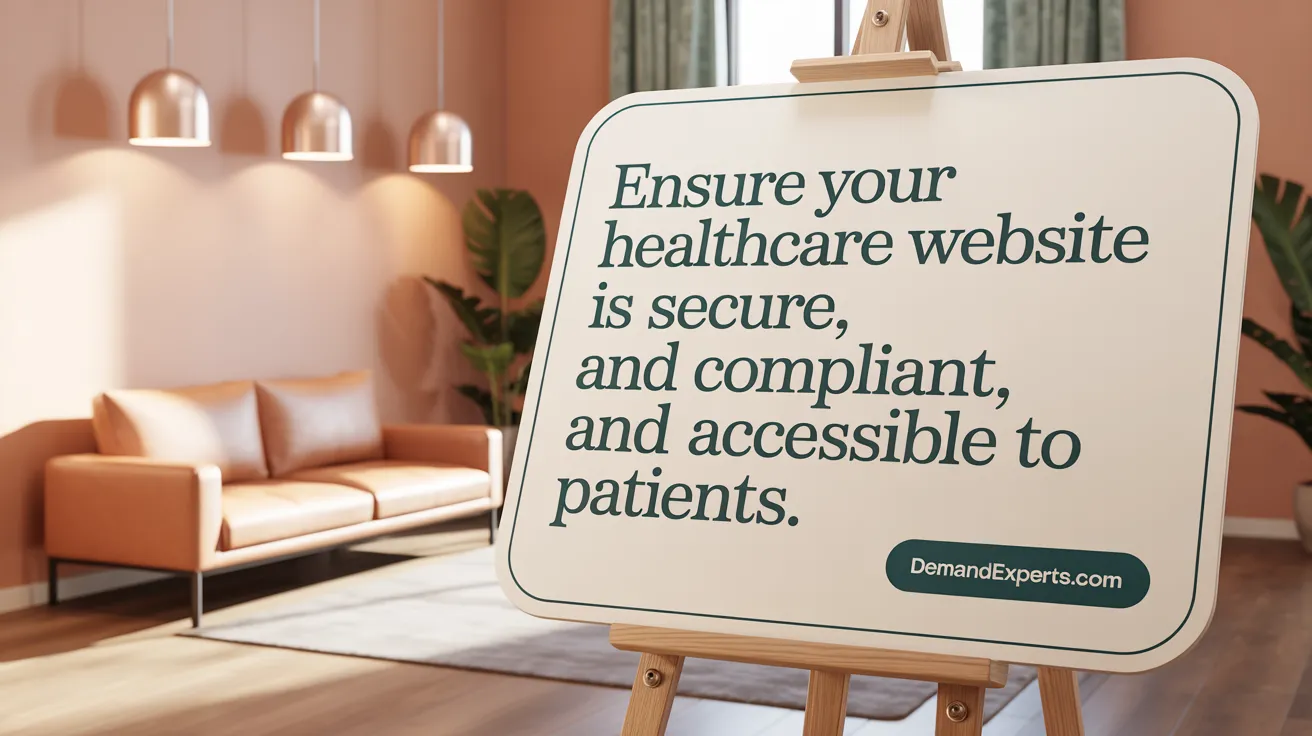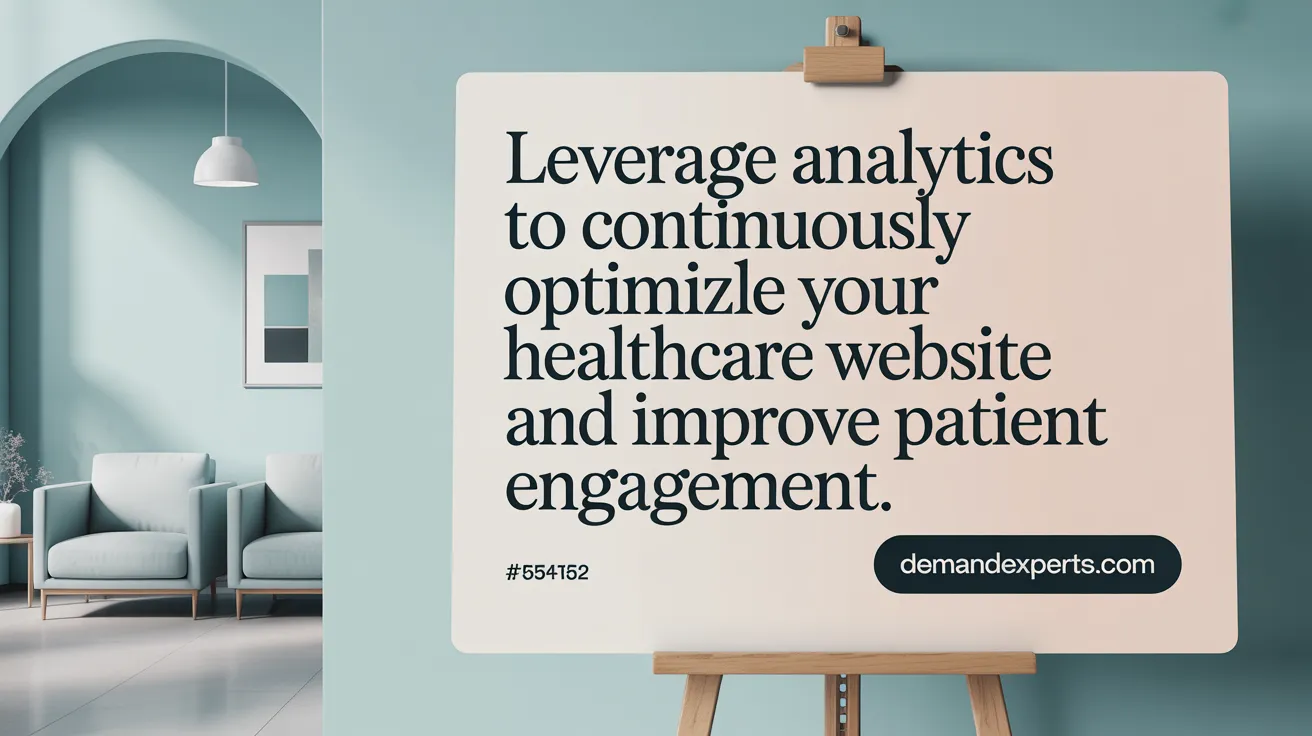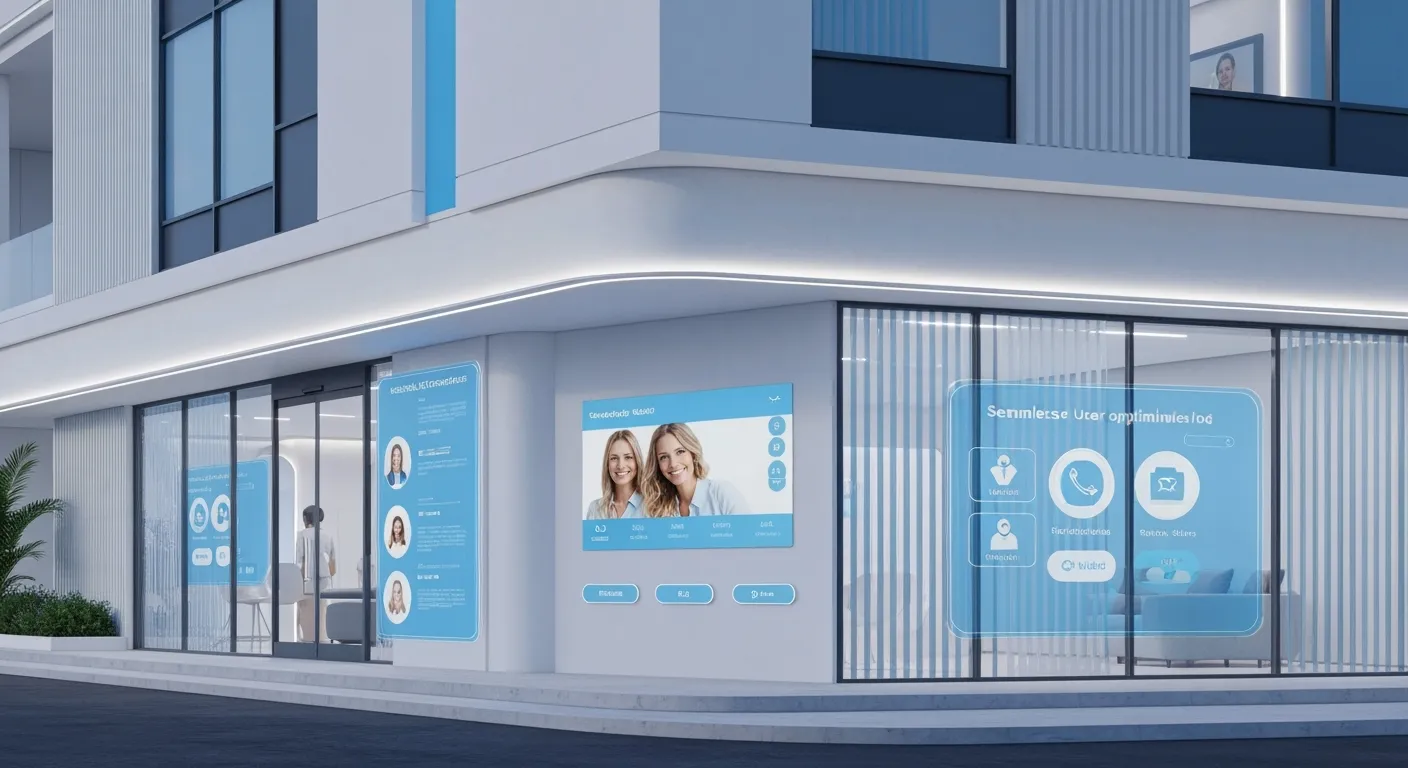The Critical Role of Website Optimization in Healthcare Clinics
In today's digital landscape, healthcare clinics must prioritize website optimization to effectively attract and engage patients. With over a billion health-related queries conducted daily on Google and a growing reliance on online resources for healthcare decisions, a well-optimized website is essential. This narrative explores the best practices for healthcare clinics to enhance their website performance, improve search engine rankings, foster patient trust, and streamline user experience.
Fundamentals of Healthcare SEO: Building Visibility and Trust
Why is SEO critical for healthcare clinic websites?
SEO is vital for healthcare clinics because over 60% of web traffic to healthcare-related sites originates from organic search. With Google handling more than 90% of health-related queries, optimizing for search engines significantly enhances a clinic's online visibility. Effective SEO not only attracts the right patients but also helps build credibility and trust, which are crucial in healthcare. Additionally, SEO delivers measurable marketing results through analytics, helping clinics understand their audience and adjust strategies accordingly (Boost Healthcare SEO, Healthcare SEO 2025).
What are the essential SEO elements healthcare clinics must focus on?
To succeed with SEO, healthcare clinics should concentrate on multiple core factors:
- Keyword research: Focus on long-tail and location-specific keywords to target relevant and intent-driven searches (Healthcare SEO basics, Search Engine Optimization for Doctors).
- Content quality: Create authoritative, experience-based, and trustworthy (EEAT) content tailored to patient needs (Medical SEO Best Practices, EEAT and YMYL in Healthcare SEO.
- Site structure: Use well-organized and descriptive URLs, optimized meta titles, and meta descriptions (SEO Starter Guide, Optimizing Healthcare Websites).
- Technical optimization: Ensure mobile responsiveness, fast page speeds, and secure HTTPS protocols (Technical SEO for Medical Websites, Healthcare SEO basics).
- Backlinks: Build relationships with reputable sources to gain authoritative backlinks that improve rankings (The role of backlinks and local SEO).
- Continuous updates: Regularly refresh content to stay relevant and improve search ranking signals (Medical SEO Best Practices, Regular content maintenance).
EEAT and YMYL considerations
Healthcare websites must meet high standards due to the sensitive nature of medical content. EEAT principles—Experience, Expertise, Authority, and Trustworthiness—are essential to demonstrate reliability. Additionally, YMYL (Your Money or Your Life) guidelines require that content influencing health decisions be accurate and reviewed by medical experts, ensuring patient safety and compliance (EEAT and YMYL in Healthcare SEO, Medical SEO Best Practices).
The role of backlinks and local SEO
Backlinks from trusted sources like medical associations or health directories add credibility, boosting search rankings. Local SEO tactics, including optimizing Google Business Profiles and maintaining consistent Name, Address, and Phone (NAP) information, are crucial for clinics targeting nearby patients. Positive patient reviews on platforms like Google Reviews further strengthen local search presence (Healthcare SEO basics, Boost Healthcare SEO.
Avoiding outdated SEO practices
Modern healthcare SEO avoids keyword stuffing and neglecting mobile optimization. It also steers clear of outdated technologies such as excessive Flash usage that impair search visibility. Instead, it embraces natural content integration, accessibility, and user-friendly design to align with current search engine algorithms and user expectations (SEO Starter Guide, Medical SEO Best Practices.
Design Principles for Healthcare Websites: Simplicity and Accessibility

How should healthcare clinic websites be designed for optimal user experience?
Healthcare clinic websites should feature a clean and user-friendly design that eliminates clutter and emphasizes simplicity. This helps users focus on essential information without distraction. Intuitive navigation, including clear menus and logical site structure, enables visitors to quickly locate the resources they need (Healthcare Website Navigation, Seamless navigation in healthcare sites.
Incorporating a robust site search function with features like autocomplete and categorization enhances usability, allowing patients to find specific health information or services efficiently (Mayo Clinic search functionality, healthcare website autocomplete search).
Accessibility compliance is critical. Adhering to standards such as WCAG 2.1 AA and Section 508 ensures that websites are usable for all individuals, including those with disabilities. This involves using high-contrast color schemes, large and readable fonts, keyboard navigability, and descriptive alt text for images (website accessibility WCAG 2.2 AA, Accessibility Features for Patient Engagement, Accessibility in healthcare SEO.
Color choices play a vital role; white is often used as the primary background color to create a sense of calm and clarity, while blue serves as a trusted complementary color that conveys reliability. A thoughtful visual hierarchy directs users’ attention to important areas such as calls to action and key content (Color Design for Medical Websites, Clear call-to-action healthcare sites, Calls-to-action in healthcare marketing.
Finally, mobile responsiveness is essential. The website must adapt seamlessly to various screen sizes and devices, from desktops to smartphones, providing a consistent and optimized viewing experience. Given that a significant percentage of patients research healthcare providers on mobile devices, this ensures that the site remains accessible and engaging regardless of how users access it (Mobile Responsiveness in Healthcare SEO, Mobile-friendly healthcare design, Mobile-responsive medical websites).
Content Strategy: Creating Engaging, Authoritative, and Evergreen Material

What content strategies increase patient engagement and SEO?
Effective healthcare website content follows the five E’s: Effectiveness, Ease, Engagement, Everlasting quality, and Error prevention. This means content must convey clear, accurate medical information that patients find easy to read and understand while being engaging enough to keep them interested.
Clinician-reviewed, patient-focused content establishes expertise and trustworthiness, which are critical under Google's EEAT guidelines for health topics. Originality and authority of information help boost search engine rankings and patient confidence.
Incorporation of multimedia (images, videos, infographics)
Adding multimedia elements significantly enhances content appeal and SEO. Content with images receives 94% more views, and websites featuring videos are 50 times more likely to appear on Google’s first page. Short videos around 30 seconds are especially effective on mobile, with 88% of viewers watching to completion.
Using infographics and videos simplifies complex medical topics and increases the time visitors spend on the site, positively impacting SEO and user experience, as explained in Healthcare Multimedia Content SEO and Video Marketing Benefits in Healthcare.
Regular content updates and FAQs
Consistently updating website content keeps information current and relevant, crucial for patient trust and search engine favorability. Including regularly refreshed FAQs addresses common patient questions and improves keyword relevance as recommended in Updating Medical Website Content and Regular content maintenance for SEO.
Tips, health news, and expert Q&A sessions hosted online encourage visitors to return and engage more deeply with the website, supporting continuous website optimization in healthcare.
Patient testimonials and reviews
Showcasing patient testimonials and reviews directly on the website helps build credibility and social proof. Most patients trust online reviews as much as personal recommendations, which enhances the practice’s trustworthiness and SEO rankings according to Patient Testimonials SEO Benefits and Encouraging Patient Reviews.
Encouraging reviews on platforms like Google Reviews and timely responses to negative feedback supports reputation management and patient engagement, as explained in Managing Negative Reviews and Managing online reviews for healthcare.
Overall, integrating the five E’s, clinician-verified info, compelling multimedia, ongoing updates, and social proof forms a robust content strategy that attracts and retains patients while strengthening search engine visibility.
Technical SEO and Website Performance Optimization
Which technical SEO aspects are critical for healthcare websites?
Critical technical SEO factors include optimizing site speed to reduce load times, ensuring mobile responsiveness, securing the site with HTTPS and SSL certificates, fixing broken links, and implementing structured data/schema markup to improve search engine understanding and ranking (Technical SEO for Medical Websites, Technical SEO in Healthcare, Technical SEO Optimization.
Site speed and load time improvements
Healthcare websites must prioritize fast loading speeds to boost user satisfaction and SEO rankings. Tools like Google’s PageSpeed Insights help identify bottlenecks. Optimizing images, leveraging caching, and improving server response times significantly reduce load times (Improving Healthcare Website SEO, Improving Healthcare Site Speed, Improving Page Speed for Medical Sites.
Mobile optimization and responsive design
With over 44% of patients researching healthcare on mobile devices, responsive design ensures consistent performance across smartphones and tablets. Mobile-friendly sites provide easy navigation and better accessibility, directly influencing SEO rankings and patient engagement (Mobile Responsiveness in Healthcare SEO, Mobile-Friendly Healthcare Design, Mobile Optimization for Hospital Appointments).
Secure HTTPS protocols and SSL certificates
Securing sensitive patient information is essential. Using HTTPS protocols with SSL certificates encrypts data, builds patient trust, and enhances Google search rankings as secure sites are favored by search algorithms (Securing Healthcare Websites with HTTPS, SSL Certificates for Medical Sites, Healthcare Website Security Practices).
Fixing broken links and technical errors
Broken links create a poor user experience and hinder search engine crawling. Regular website audits can detect and fix broken URLs, 404 errors, and other technical issues to maintain site credibility and SEO health (Regular Content Maintenance, Managing Broken Links.
Structured data and schema markup
Adding structured data via schema markup helps search engines better interpret healthcare content. This inclusion improves visibility in search results through rich snippets and enhances user understanding of key medical information (Healthcare Structured Data, Meta Tags and Structured Data.
Enhancing User Experience Through Conversion Rate Optimization (CRO)
How can healthcare websites convert visitors into patients more effectively?
Healthcare websites improve conversion by understanding and mapping patient user journeys. This involves analyzing how visitors interact with the site and what paths they follow, so the website can anticipate visitor needs and guide them toward desired actions (User journey mapping in healthcare, Patient journey mapping.
Mapping patient user journeys
By creating audience personas and mapping typical patient behaviors, sites can tailor the user experience, making navigation intuitive and focusing on meaningful engagement points like appointment booking or signing up for newsletters (User-centric healthcare web design, Creating audience personas).
A/B testing for calls-to-action (CTAs)
A/B testing helps determine which CTA designs, wording, and placements perform best. By experimenting with different button colors, sizes, and phrasing, healthcare sites learn what drives higher click-through and action rates (A/B Testing for Healthcare Websites, Calls-to-action in healthcare sites.
Strategic CTA placement
Effective placement of CTAs in visible and contextually relevant locations—such as at the end of informative pages or alongside provider information—increases the chances of patient interaction. Prominent, clear, and easy-to-click buttons improve user experience and encourage next steps (Call-to-Action Buttons in Healthcare, Clear call-to-action healthcare sites.
Tracking and analyzing user behavior
Using analytics tools like Google Analytics, heatmaps, and conversion tracking platforms allows healthcare providers to monitor key metrics such as bounce rate, session duration, and conversion rates. This data informs ongoing website refinements (Healthcare website analytics tools, Using Google Analytics for healthcare.
Tools for CRO in healthcare websites
Popular tools include Google Analytics for visitor data, heatmap tools to visualize interaction areas, and specialized CRO platforms that assist with experimenting on layouts and CTAs. These combined insights facilitate continuous improvement and optimized patient acquisition (Conversion Rate Optimization Techniques, Performance monitoring tools).
By integrating these strategies, healthcare websites create a seamless and engaging online journey that effectively converts visitors into patients (Optimizing Healthcare Websites, Effective healthcare SEO strategies.
Leveraging Multimedia Content for Increased Engagement and SEO Benefits
What role does multimedia play in healthcare website optimization?
Multimedia is a powerful tool in healthcare website optimization, significantly enhancing both user engagement and search engine rankings. Adding images, infographics, and videos makes content more appealing and easier to consume, which increases visitor time on the site. Studies show that healthcare content with images can receive up to 94% more views, making visual content a must-have for attracting and retaining visitors (Using Visual Content in Healthcare SEO, Healthcare multimedia content SEO.
Use of images, infographics, and videos
Images and infographics simplify complex health information, while videos bring stories and concepts to life, helping patients connect with the content emotionally. This not only helps educate visitors but also encourages them to explore the site further (Healthcare videos SEO, Effective Medical Website Content, Engaging medical content.
Video optimization for search ranking
Videos properly optimized with relevant titles, descriptions, and embedded on dedicated pages greatly improve the chances of a website ranking on the first page of Google search results. Videos make a site 50 times more likely to appear in top search listings, showing their immense SEO value (Optimizing videos for search, Relevant titles and descriptions for videos).
Short mobile-friendly videos
Short videos, particularly those around 30 seconds, perform exceptionally well on mobile devices, with 88% of viewers watching them to completion. These quick, engaging videos cater perfectly to users’ shorter attention spans on handheld devices (Short Videos for Mobile Engagement.
Visual storytelling techniques
Using visuals alongside concise text and subtitles helps explain medical topics clearly and memorably. Animation, patient testimonials, and step-by-step infographics also enhance storytelling, making healthcare information accessible and trustworthy (Healthcare Website SEO Tips, Patient Testimonials SEO Benefits, Visual storytelling in healthcare.
Alt text and metadata for multimedia
Including descriptive alt text and relevant metadata for all images and videos is critical. This practice improves accessibility for users with disabilities and boosts SEO by enabling search engines to understand and index multimedia content correctly (Using descriptive alt text for images, Alt text for healthcare websites.
By strategically incorporating well-optimized multimedia, healthcare websites can significantly increase engagement, improve user experience, and enhance their search engine performance (Medical SEO Best Practices, Optimizing Healthcare Websites.
Building Trust and Credibility with Patient Testimonials and Reviews

How do patient testimonials and reviews impact healthcare website success?
Patient testimonials and online reviews play a pivotal role in healthcare website success by building trust and credibility. Since most patients regard online reviews as equally trustworthy as personal recommendations, featuring authentic feedback can significantly influence patient decisions. These testimonials also contribute to SEO by providing fresh, relevant content that improves search rankings and attracts more organic traffic. Moreover, positive reviews encourage new patient inquiries and help retain existing patients.
Importance of reviews for SEO and patient trust
Patient reviews enhance a healthcare provider's online presence by increasing keyword-rich, user-generated content. This ongoing influx of information signals to search engines that the website is active and engaging, boosting rankings. From a patient perspective, authentic stories and feedback reduce uncertainty and foster confidence in choosing a provider. For more details, see Patient Testimonials SEO Benefits.
Platforms for collecting patient feedback
Effective collection of patient feedback happens on platforms like Google Reviews, Healthgrades, and Yelp. Encouraging reviews on these widely accessed sites helps broaden visibility and search engine reach. Integrations within the healthcare website can also prompt patients to submit feedback easily, enhancing overall collection efforts. Refer to Managing Negative Reviews and Managing online reviews for healthcare for strategies.
Handling negative reviews professionally
Addressing negative reviews with empathy and professionalism is crucial for reputation management. Prompt, constructive responses show commitment to patient satisfaction and can mitigate harm. Transparent engagement reassures prospective patients that their concerns will be heard and managed respectfully. See Encouraging Patient Reviews and Managing online reviews for healthcare for best practices.
Showcasing trust symbols and awards
Displaying accreditation badges, certifications, awards, and expert endorsements alongside testimonials strengthens credibility. Trust symbols visually communicate a practice’s qualifications and reliability, further reassuring visitors. Additional insights available at Trust Symbols for Healthcare Websites.
Social proof as a conversion driver
Social proof, including patient stories and success cases, acts as a powerful conversion driver by demonstrating real-world benefits. This involvement helps potential patients envision positive outcomes and motivates them to take action such as scheduling appointments or consultations. More on leveraging social proof in healthcare marketing is covered in Leveraging Social Proof in Healthcare.
Local SEO Strategies to Attract Nearby Patients
What local SEO tactics can healthcare clinics use to attract patients?
Healthcare clinics can leverage several local SEO strategies to better reach patients in their vicinity. A fundamental step is claiming and optimizing their Google Business Profile for healthcare along with other local listing platforms such as Bing Places setup. This ensures accurate visibility on search engine results and maps.
Maintaining consistent NAP information—Name, Address, and Phone number—is critical across all online directories and the clinic’s website. This consistency helps search engines verify the clinic’s legitimacy and local presence, as explained in Local listings optimization.
Incorporating location-specific and long-tail keywords, like "emergency hospital Los Angeles" or "pediatrician near downtown," into website content, meta descriptions, and blog posts improves relevance for local search queries. See Targeting relevant patient audiences and Long-tail medical keywords.
Encouraging patients to post reviews on platforms like Google Reviews, Healthgrades, or Yelp builds social proof and boosts local search rankings. Clinics should engage with these reviews promptly to enhance reputation, as covered in Managing online reviews for healthcare and Encouraging Patient Reviews.
Finally, tailoring website content to emphasize local services and utilizing schema markup for local business information increases the chances of appearing in localized search results and Google’s local pack.
Together, these tactics create a cohesive local SEO approach that helps clinics appear prominently when nearby patients search for healthcare services.
Compliance and Security: Safeguarding Patient Data and Ensuring Accessibility

How do healthcare clinics ensure website compliance and data security?
Healthcare clinics prioritize compliance and security by adhering to HIPAA guidelines, which mandate robust data privacy measures. This involves using SSL certificates to encrypt sensitive patient data transmitted through the website, ensuring secure online interactions such as appointment scheduling and patient form submissions.
Accessibility is equally critical. Clinics must meet ADA and WCAG standards, which require features like alt text for images, sufficient color contrast, and easy navigation for users with disabilities. Incorporating these standards makes healthcare websites inclusive, reaching a broader audience and complying with legal requirements.
Regular accessibility audits are conducted to review and update website features, keeping pace with evolving regulations and technologies. These audits help identify and fix issues such as broken alt texts or insufficient contrast, ensuring ongoing compliance.
Balancing strict compliance with a seamless user experience is vital. Overly complicated security or accessibility features can hinder patient engagement. Therefore, websites deploy optimized user journeys and smooth navigation paths while maintaining protective protocols.
By combining HIPAA compliance, accessibility standards adherence, encryption technologies, and continuous updates, healthcare clinics safeguard patient information and create trustworthy, inclusive online environments.
Measuring Success: Analytics and Continuous Website Improvement

Which tools and metrics help healthcare clinics optimize their websites continuously?
Healthcare clinics leverage analytics tools like Google Analytics for healthcare and heatmaps for healthcare sites to closely observe how visitors interact with their websites. These platforms provide detailed insights into key performance indicators (KPIs) including bounce rates, session duration, and conversion rates, helping clinics understand user engagement and identify points where visitors might lose interest.
How do regular audits and tests contribute to website improvement?
Regular audits such as website speed tests and A/B testing for healthcare websites play crucial roles in refining healthcare websites. Speed tests ensure fast loading times, essential for user retention and SEO rankings. A/B testing compares different page layouts or content approaches, revealing which variants better support patient journeys and calls to action.
Why is adjusting strategies based on data important?
Data-driven adjustments enable healthcare websites to remain responsive to evolving visitor behaviors and preferences. By analyzing metrics and test outcomes, clinics can refine content, navigation, and technical features, maintaining a patient-centric experience that improves appointment bookings and information discovery, as highlighted in continuous website optimization in healthcare and data-driven healthcare website updates.
What are the benefits of continuous incremental updates?
Implementing ongoing, incremental changes avoids disruptive overhauls and helps the site steadily adapt to new healthcare trends and technological advances. This continuous improvement builds visitor trust, ensures compliance with regulations, and sustains high search engine visibility over time. For more details see continuous improvement for healthcare websites and Healthcare SEO best practices.
Integrating Patient Engagement Features: Enhancing Interaction and Convenience
What patient engagement features improve healthcare website effectiveness?
Healthcare websites significantly benefit from features that enhance patient interaction and streamline services. Online appointment scheduling provides patients with a convenient way to book visits without needing to call, saving time and improving satisfaction.
Secure patient portals and HIPAA-compliant forms allow safe transmission and management of sensitive health data, fostering trust and meeting regulatory standards. Live chat options that comply with HIPAA ensure real-time, private communication between patients and healthcare providers.
Including clear calls-to-action for donations and volunteer opportunities encourages community involvement and support. Mobile-friendly interactive elements such as easy navigation and responsive design ensure patients can access services anytime, anywhere, across all devices.
These patient engagement tools not only improve user convenience but also empower patients to take an active role in managing their health digitally. They contribute to higher patient retention, better communication, and overall improved patient experience in today’s digital healthcare environment.
Promoting Healthcare Websites Through Multi-Channel Digital Marketing
How can healthcare clinics effectively promote their websites beyond SEO?
Healthcare clinics can enhance their website's reach and patient engagement by adopting a multi-channel digital marketing approach that goes beyond traditional SEO strategies.
Social media engagement and advertising
Social media platforms serve as vital channels for connecting with both potential and existing patients. By maintaining active profiles, clinics can share informative content, updates, and patient stories. Targeted advertisements on platforms like Facebook and Instagram allow precise demographic outreach, increasing the chances of attracting new patients effectively. Learn more about social media marketing in healthcare.
Email marketing with educational content
Email campaigns remain a cost-effective tool for patient communication. Sending mobile-optimized newsletters that offer educational content and clear calls to action helps inform patients about new services or health tips. Personalized email outreach can foster stronger patient relationships and encourage appointment bookings. See details on effective email marketing in healthcare.
Contextual and programmatic advertising
In light of evolving privacy regulations such as HIPAA, contextual advertising offers a privacy-conscious approach by displaying ads related to the content users engage with rather than tracking individual behaviors. Programmatic strategies integrating native and video ads across connected TV (CTV), digital out-of-home (DOOH), and other channels can increase campaign reach and effectiveness. Explore privacy-conscious digital advertising in healthcare.
Offline promotion complementing digital efforts
Traditional media, including digital television and radio, complements online marketing by providing enhanced interaction and visual impact. These offline channels help expand the audience base, reinforce digital messages, and maintain ongoing communication with the community. For more information, see digital advertising in healthcare.
Leveraging CRM platforms for personalization
Healthcare Customer Relationship Management (HCRM) platforms allow clinics to use detailed patient data such as demographics and interaction history to tailor marketing campaigns. These personalized campaigns improve patient retention by addressing individual needs and preferences more effectively. Learn about personalized healthcare campaigns with CRM.
Together, these strategies create an integrated marketing ecosystem that maximizes website visibility, attracts new patients, and nurtures ongoing engagement beyond what SEO alone can achieve.
Sustaining Excellence in Healthcare Website Optimization
Optimizing a healthcare clinic’s website is a dynamic, multifaceted process intertwining SEO, design, content creation, technical performance, compliance, and continuous improvement. By adopting these best practices, clinics can enhance online visibility, strengthen patient trust, and ultimately facilitate better health outcomes through improved patient engagement. As search behaviors and technologies evolve, committing to a patient-centered, data-informed website strategy will ensure healthcare providers remain accessible, credible, and competitive in the digital era.
The Critical Role of Website Optimization in Healthcare Clinics
In today's digital landscape, healthcare clinics must prioritize website optimization to effectively attract and engage patients. With over a billion health-related queries conducted daily on Google and a growing reliance on online resources for healthcare decisions, a well-optimized website is essential. This narrative explores the best practices for healthcare clinics to enhance their website performance, improve search engine rankings, foster patient trust, and streamline user experience.
Fundamentals of Healthcare SEO: Building Visibility and Trust
Why is SEO critical for healthcare clinic websites?
SEO is vital for healthcare clinics because over 60% of web traffic to healthcare-related sites originates from organic search. With Google handling more than 90% of health-related queries, optimizing for search engines significantly enhances a clinic's online visibility. Effective SEO not only attracts the right patients but also helps build credibility and trust, which are crucial in healthcare. Additionally, SEO delivers measurable marketing results through analytics, helping clinics understand their audience and adjust strategies accordingly (Boost Healthcare SEO, Healthcare SEO 2025).
What are the essential SEO elements healthcare clinics must focus on?
To succeed with SEO, healthcare clinics should concentrate on multiple core factors:
- Keyword research: Focus on long-tail and location-specific keywords to target relevant and intent-driven searches (Healthcare SEO basics, Search Engine Optimization for Doctors).
- Content quality: Create authoritative, experience-based, and trustworthy (EEAT) content tailored to patient needs (Medical SEO Best Practices, EEAT and YMYL in Healthcare SEO.
- Site structure: Use well-organized and descriptive URLs, optimized meta titles, and meta descriptions (SEO Starter Guide, Optimizing Healthcare Websites).
- Technical optimization: Ensure mobile responsiveness, fast page speeds, and secure HTTPS protocols (Technical SEO for Medical Websites, Healthcare SEO basics).
- Backlinks: Build relationships with reputable sources to gain authoritative backlinks that improve rankings (The role of backlinks and local SEO).
- Continuous updates: Regularly refresh content to stay relevant and improve search ranking signals (Medical SEO Best Practices, Regular content maintenance).
EEAT and YMYL considerations
Healthcare websites must meet high standards due to the sensitive nature of medical content. EEAT principles—Experience, Expertise, Authority, and Trustworthiness—are essential to demonstrate reliability. Additionally, YMYL (Your Money or Your Life) guidelines require that content influencing health decisions be accurate and reviewed by medical experts, ensuring patient safety and compliance (EEAT and YMYL in Healthcare SEO, Medical SEO Best Practices).
The role of backlinks and local SEO
Backlinks from trusted sources like medical associations or health directories add credibility, boosting search rankings. Local SEO tactics, including optimizing Google Business Profiles and maintaining consistent Name, Address, and Phone (NAP) information, are crucial for clinics targeting nearby patients. Positive patient reviews on platforms like Google Reviews further strengthen local search presence (Healthcare SEO basics, Boost Healthcare SEO.
Avoiding outdated SEO practices
Modern healthcare SEO avoids keyword stuffing and neglecting mobile optimization. It also steers clear of outdated technologies such as excessive Flash usage that impair search visibility. Instead, it embraces natural content integration, accessibility, and user-friendly design to align with current search engine algorithms and user expectations (SEO Starter Guide, Medical SEO Best Practices.
Design Principles for Healthcare Websites: Simplicity and Accessibility

How should healthcare clinic websites be designed for optimal user experience?
Healthcare clinic websites should feature a clean and user-friendly design that eliminates clutter and emphasizes simplicity. This helps users focus on essential information without distraction. Intuitive navigation, including clear menus and logical site structure, enables visitors to quickly locate the resources they need (Healthcare Website Navigation, Seamless navigation in healthcare sites.
Incorporating a robust site search function with features like autocomplete and categorization enhances usability, allowing patients to find specific health information or services efficiently (Mayo Clinic search functionality, healthcare website autocomplete search).
Accessibility compliance is critical. Adhering to standards such as WCAG 2.1 AA and Section 508 ensures that websites are usable for all individuals, including those with disabilities. This involves using high-contrast color schemes, large and readable fonts, keyboard navigability, and descriptive alt text for images (website accessibility WCAG 2.2 AA, Accessibility Features for Patient Engagement, Accessibility in healthcare SEO.
Color choices play a vital role; white is often used as the primary background color to create a sense of calm and clarity, while blue serves as a trusted complementary color that conveys reliability. A thoughtful visual hierarchy directs users’ attention to important areas such as calls to action and key content (Color Design for Medical Websites, Clear call-to-action healthcare sites, Calls-to-action in healthcare marketing.
Finally, mobile responsiveness is essential. The website must adapt seamlessly to various screen sizes and devices, from desktops to smartphones, providing a consistent and optimized viewing experience. Given that a significant percentage of patients research healthcare providers on mobile devices, this ensures that the site remains accessible and engaging regardless of how users access it (Mobile Responsiveness in Healthcare SEO, Mobile-friendly healthcare design, Mobile-responsive medical websites).
Content Strategy: Creating Engaging, Authoritative, and Evergreen Material

What content strategies increase patient engagement and SEO?
Effective healthcare website content follows the five E’s: Effectiveness, Ease, Engagement, Everlasting quality, and Error prevention. This means content must convey clear, accurate medical information that patients find easy to read and understand while being engaging enough to keep them interested.
Clinician-reviewed, patient-focused content establishes expertise and trustworthiness, which are critical under Google's EEAT guidelines for health topics. Originality and authority of information help boost search engine rankings and patient confidence.
Incorporation of multimedia (images, videos, infographics)
Adding multimedia elements significantly enhances content appeal and SEO. Content with images receives 94% more views, and websites featuring videos are 50 times more likely to appear on Google’s first page. Short videos around 30 seconds are especially effective on mobile, with 88% of viewers watching to completion.
Using infographics and videos simplifies complex medical topics and increases the time visitors spend on the site, positively impacting SEO and user experience, as explained in Healthcare Multimedia Content SEO and Video Marketing Benefits in Healthcare.
Regular content updates and FAQs
Consistently updating website content keeps information current and relevant, crucial for patient trust and search engine favorability. Including regularly refreshed FAQs addresses common patient questions and improves keyword relevance as recommended in Updating Medical Website Content and Regular content maintenance for SEO.
Tips, health news, and expert Q&A sessions hosted online encourage visitors to return and engage more deeply with the website, supporting continuous website optimization in healthcare.
Patient testimonials and reviews
Showcasing patient testimonials and reviews directly on the website helps build credibility and social proof. Most patients trust online reviews as much as personal recommendations, which enhances the practice’s trustworthiness and SEO rankings according to Patient Testimonials SEO Benefits and Encouraging Patient Reviews.
Encouraging reviews on platforms like Google Reviews and timely responses to negative feedback supports reputation management and patient engagement, as explained in Managing Negative Reviews and Managing online reviews for healthcare.
Overall, integrating the five E’s, clinician-verified info, compelling multimedia, ongoing updates, and social proof forms a robust content strategy that attracts and retains patients while strengthening search engine visibility.
Technical SEO and Website Performance Optimization
Which technical SEO aspects are critical for healthcare websites?
Critical technical SEO factors include optimizing site speed to reduce load times, ensuring mobile responsiveness, securing the site with HTTPS and SSL certificates, fixing broken links, and implementing structured data/schema markup to improve search engine understanding and ranking (Technical SEO for Medical Websites, Technical SEO in Healthcare, Technical SEO Optimization.
Site speed and load time improvements
Healthcare websites must prioritize fast loading speeds to boost user satisfaction and SEO rankings. Tools like Google’s PageSpeed Insights help identify bottlenecks. Optimizing images, leveraging caching, and improving server response times significantly reduce load times (Improving Healthcare Website SEO, Improving Healthcare Site Speed, Improving Page Speed for Medical Sites.
Mobile optimization and responsive design
With over 44% of patients researching healthcare on mobile devices, responsive design ensures consistent performance across smartphones and tablets. Mobile-friendly sites provide easy navigation and better accessibility, directly influencing SEO rankings and patient engagement (Mobile Responsiveness in Healthcare SEO, Mobile-Friendly Healthcare Design, Mobile Optimization for Hospital Appointments).
Secure HTTPS protocols and SSL certificates
Securing sensitive patient information is essential. Using HTTPS protocols with SSL certificates encrypts data, builds patient trust, and enhances Google search rankings as secure sites are favored by search algorithms (Securing Healthcare Websites with HTTPS, SSL Certificates for Medical Sites, Healthcare Website Security Practices).
Fixing broken links and technical errors
Broken links create a poor user experience and hinder search engine crawling. Regular website audits can detect and fix broken URLs, 404 errors, and other technical issues to maintain site credibility and SEO health (Regular Content Maintenance, Managing Broken Links.
Structured data and schema markup
Adding structured data via schema markup helps search engines better interpret healthcare content. This inclusion improves visibility in search results through rich snippets and enhances user understanding of key medical information (Healthcare Structured Data, Meta Tags and Structured Data.
Enhancing User Experience Through Conversion Rate Optimization (CRO)
How can healthcare websites convert visitors into patients more effectively?
Healthcare websites improve conversion by understanding and mapping patient user journeys. This involves analyzing how visitors interact with the site and what paths they follow, so the website can anticipate visitor needs and guide them toward desired actions (User journey mapping in healthcare, Patient journey mapping.
Mapping patient user journeys
By creating audience personas and mapping typical patient behaviors, sites can tailor the user experience, making navigation intuitive and focusing on meaningful engagement points like appointment booking or signing up for newsletters (User-centric healthcare web design, Creating audience personas).
A/B testing for calls-to-action (CTAs)
A/B testing helps determine which CTA designs, wording, and placements perform best. By experimenting with different button colors, sizes, and phrasing, healthcare sites learn what drives higher click-through and action rates (A/B Testing for Healthcare Websites, Calls-to-action in healthcare sites.
Strategic CTA placement
Effective placement of CTAs in visible and contextually relevant locations—such as at the end of informative pages or alongside provider information—increases the chances of patient interaction. Prominent, clear, and easy-to-click buttons improve user experience and encourage next steps (Call-to-Action Buttons in Healthcare, Clear call-to-action healthcare sites.
Tracking and analyzing user behavior
Using analytics tools like Google Analytics, heatmaps, and conversion tracking platforms allows healthcare providers to monitor key metrics such as bounce rate, session duration, and conversion rates. This data informs ongoing website refinements (Healthcare website analytics tools, Using Google Analytics for healthcare.
Tools for CRO in healthcare websites
Popular tools include Google Analytics for visitor data, heatmap tools to visualize interaction areas, and specialized CRO platforms that assist with experimenting on layouts and CTAs. These combined insights facilitate continuous improvement and optimized patient acquisition (Conversion Rate Optimization Techniques, Performance monitoring tools).
By integrating these strategies, healthcare websites create a seamless and engaging online journey that effectively converts visitors into patients (Optimizing Healthcare Websites, Effective healthcare SEO strategies.
Leveraging Multimedia Content for Increased Engagement and SEO Benefits
What role does multimedia play in healthcare website optimization?
Multimedia is a powerful tool in healthcare website optimization, significantly enhancing both user engagement and search engine rankings. Adding images, infographics, and videos makes content more appealing and easier to consume, which increases visitor time on the site. Studies show that healthcare content with images can receive up to 94% more views, making visual content a must-have for attracting and retaining visitors (Using Visual Content in Healthcare SEO, Healthcare multimedia content SEO.
Use of images, infographics, and videos
Images and infographics simplify complex health information, while videos bring stories and concepts to life, helping patients connect with the content emotionally. This not only helps educate visitors but also encourages them to explore the site further (Healthcare videos SEO, Effective Medical Website Content, Engaging medical content.
Video optimization for search ranking
Videos properly optimized with relevant titles, descriptions, and embedded on dedicated pages greatly improve the chances of a website ranking on the first page of Google search results. Videos make a site 50 times more likely to appear in top search listings, showing their immense SEO value (Optimizing videos for search, Relevant titles and descriptions for videos).
Short mobile-friendly videos
Short videos, particularly those around 30 seconds, perform exceptionally well on mobile devices, with 88% of viewers watching them to completion. These quick, engaging videos cater perfectly to users’ shorter attention spans on handheld devices (Short Videos for Mobile Engagement.
Visual storytelling techniques
Using visuals alongside concise text and subtitles helps explain medical topics clearly and memorably. Animation, patient testimonials, and step-by-step infographics also enhance storytelling, making healthcare information accessible and trustworthy (Healthcare Website SEO Tips, Patient Testimonials SEO Benefits, Visual storytelling in healthcare.
Alt text and metadata for multimedia
Including descriptive alt text and relevant metadata for all images and videos is critical. This practice improves accessibility for users with disabilities and boosts SEO by enabling search engines to understand and index multimedia content correctly (Using descriptive alt text for images, Alt text for healthcare websites.
By strategically incorporating well-optimized multimedia, healthcare websites can significantly increase engagement, improve user experience, and enhance their search engine performance (Medical SEO Best Practices, Optimizing Healthcare Websites.
Building Trust and Credibility with Patient Testimonials and Reviews

How do patient testimonials and reviews impact healthcare website success?
Patient testimonials and online reviews play a pivotal role in healthcare website success by building trust and credibility. Since most patients regard online reviews as equally trustworthy as personal recommendations, featuring authentic feedback can significantly influence patient decisions. These testimonials also contribute to SEO by providing fresh, relevant content that improves search rankings and attracts more organic traffic. Moreover, positive reviews encourage new patient inquiries and help retain existing patients.
Importance of reviews for SEO and patient trust
Patient reviews enhance a healthcare provider's online presence by increasing keyword-rich, user-generated content. This ongoing influx of information signals to search engines that the website is active and engaging, boosting rankings. From a patient perspective, authentic stories and feedback reduce uncertainty and foster confidence in choosing a provider. For more details, see Patient Testimonials SEO Benefits.
Platforms for collecting patient feedback
Effective collection of patient feedback happens on platforms like Google Reviews, Healthgrades, and Yelp. Encouraging reviews on these widely accessed sites helps broaden visibility and search engine reach. Integrations within the healthcare website can also prompt patients to submit feedback easily, enhancing overall collection efforts. Refer to Managing Negative Reviews and Managing online reviews for healthcare for strategies.
Handling negative reviews professionally
Addressing negative reviews with empathy and professionalism is crucial for reputation management. Prompt, constructive responses show commitment to patient satisfaction and can mitigate harm. Transparent engagement reassures prospective patients that their concerns will be heard and managed respectfully. See Encouraging Patient Reviews and Managing online reviews for healthcare for best practices.
Showcasing trust symbols and awards
Displaying accreditation badges, certifications, awards, and expert endorsements alongside testimonials strengthens credibility. Trust symbols visually communicate a practice’s qualifications and reliability, further reassuring visitors. Additional insights available at Trust Symbols for Healthcare Websites.
Social proof as a conversion driver
Social proof, including patient stories and success cases, acts as a powerful conversion driver by demonstrating real-world benefits. This involvement helps potential patients envision positive outcomes and motivates them to take action such as scheduling appointments or consultations. More on leveraging social proof in healthcare marketing is covered in Leveraging Social Proof in Healthcare.
Local SEO Strategies to Attract Nearby Patients
What local SEO tactics can healthcare clinics use to attract patients?
Healthcare clinics can leverage several local SEO strategies to better reach patients in their vicinity. A fundamental step is claiming and optimizing their Google Business Profile for healthcare along with other local listing platforms such as Bing Places setup. This ensures accurate visibility on search engine results and maps.
Maintaining consistent NAP information—Name, Address, and Phone number—is critical across all online directories and the clinic’s website. This consistency helps search engines verify the clinic’s legitimacy and local presence, as explained in Local listings optimization.
Incorporating location-specific and long-tail keywords, like "emergency hospital Los Angeles" or "pediatrician near downtown," into website content, meta descriptions, and blog posts improves relevance for local search queries. See Targeting relevant patient audiences and Long-tail medical keywords.
Encouraging patients to post reviews on platforms like Google Reviews, Healthgrades, or Yelp builds social proof and boosts local search rankings. Clinics should engage with these reviews promptly to enhance reputation, as covered in Managing online reviews for healthcare and Encouraging Patient Reviews.
Finally, tailoring website content to emphasize local services and utilizing schema markup for local business information increases the chances of appearing in localized search results and Google’s local pack.
Together, these tactics create a cohesive local SEO approach that helps clinics appear prominently when nearby patients search for healthcare services.
Compliance and Security: Safeguarding Patient Data and Ensuring Accessibility

How do healthcare clinics ensure website compliance and data security?
Healthcare clinics prioritize compliance and security by adhering to HIPAA guidelines, which mandate robust data privacy measures. This involves using SSL certificates to encrypt sensitive patient data transmitted through the website, ensuring secure online interactions such as appointment scheduling and patient form submissions.
Accessibility is equally critical. Clinics must meet ADA and WCAG standards, which require features like alt text for images, sufficient color contrast, and easy navigation for users with disabilities. Incorporating these standards makes healthcare websites inclusive, reaching a broader audience and complying with legal requirements.
Regular accessibility audits are conducted to review and update website features, keeping pace with evolving regulations and technologies. These audits help identify and fix issues such as broken alt texts or insufficient contrast, ensuring ongoing compliance.
Balancing strict compliance with a seamless user experience is vital. Overly complicated security or accessibility features can hinder patient engagement. Therefore, websites deploy optimized user journeys and smooth navigation paths while maintaining protective protocols.
By combining HIPAA compliance, accessibility standards adherence, encryption technologies, and continuous updates, healthcare clinics safeguard patient information and create trustworthy, inclusive online environments.
Measuring Success: Analytics and Continuous Website Improvement

Which tools and metrics help healthcare clinics optimize their websites continuously?
Healthcare clinics leverage analytics tools like Google Analytics for healthcare and heatmaps for healthcare sites to closely observe how visitors interact with their websites. These platforms provide detailed insights into key performance indicators (KPIs) including bounce rates, session duration, and conversion rates, helping clinics understand user engagement and identify points where visitors might lose interest.
How do regular audits and tests contribute to website improvement?
Regular audits such as website speed tests and A/B testing for healthcare websites play crucial roles in refining healthcare websites. Speed tests ensure fast loading times, essential for user retention and SEO rankings. A/B testing compares different page layouts or content approaches, revealing which variants better support patient journeys and calls to action.
Why is adjusting strategies based on data important?
Data-driven adjustments enable healthcare websites to remain responsive to evolving visitor behaviors and preferences. By analyzing metrics and test outcomes, clinics can refine content, navigation, and technical features, maintaining a patient-centric experience that improves appointment bookings and information discovery, as highlighted in continuous website optimization in healthcare and data-driven healthcare website updates.
What are the benefits of continuous incremental updates?
Implementing ongoing, incremental changes avoids disruptive overhauls and helps the site steadily adapt to new healthcare trends and technological advances. This continuous improvement builds visitor trust, ensures compliance with regulations, and sustains high search engine visibility over time. For more details see continuous improvement for healthcare websites and Healthcare SEO best practices.
Integrating Patient Engagement Features: Enhancing Interaction and Convenience
What patient engagement features improve healthcare website effectiveness?
Healthcare websites significantly benefit from features that enhance patient interaction and streamline services. Online appointment scheduling provides patients with a convenient way to book visits without needing to call, saving time and improving satisfaction.
Secure patient portals and HIPAA-compliant forms allow safe transmission and management of sensitive health data, fostering trust and meeting regulatory standards. Live chat options that comply with HIPAA ensure real-time, private communication between patients and healthcare providers.
Including clear calls-to-action for donations and volunteer opportunities encourages community involvement and support. Mobile-friendly interactive elements such as easy navigation and responsive design ensure patients can access services anytime, anywhere, across all devices.
These patient engagement tools not only improve user convenience but also empower patients to take an active role in managing their health digitally. They contribute to higher patient retention, better communication, and overall improved patient experience in today’s digital healthcare environment.
Promoting Healthcare Websites Through Multi-Channel Digital Marketing
How can healthcare clinics effectively promote their websites beyond SEO?
Healthcare clinics can enhance their website's reach and patient engagement by adopting a multi-channel digital marketing approach that goes beyond traditional SEO strategies.
Social media engagement and advertising
Social media platforms serve as vital channels for connecting with both potential and existing patients. By maintaining active profiles, clinics can share informative content, updates, and patient stories. Targeted advertisements on platforms like Facebook and Instagram allow precise demographic outreach, increasing the chances of attracting new patients effectively. Learn more about social media marketing in healthcare.
Email marketing with educational content
Email campaigns remain a cost-effective tool for patient communication. Sending mobile-optimized newsletters that offer educational content and clear calls to action helps inform patients about new services or health tips. Personalized email outreach can foster stronger patient relationships and encourage appointment bookings. See details on effective email marketing in healthcare.
Contextual and programmatic advertising
In light of evolving privacy regulations such as HIPAA, contextual advertising offers a privacy-conscious approach by displaying ads related to the content users engage with rather than tracking individual behaviors. Programmatic strategies integrating native and video ads across connected TV (CTV), digital out-of-home (DOOH), and other channels can increase campaign reach and effectiveness. Explore privacy-conscious digital advertising in healthcare.
Offline promotion complementing digital efforts
Traditional media, including digital television and radio, complements online marketing by providing enhanced interaction and visual impact. These offline channels help expand the audience base, reinforce digital messages, and maintain ongoing communication with the community. For more information, see digital advertising in healthcare.
Leveraging CRM platforms for personalization
Healthcare Customer Relationship Management (HCRM) platforms allow clinics to use detailed patient data such as demographics and interaction history to tailor marketing campaigns. These personalized campaigns improve patient retention by addressing individual needs and preferences more effectively. Learn about personalized healthcare campaigns with CRM.
Together, these strategies create an integrated marketing ecosystem that maximizes website visibility, attracts new patients, and nurtures ongoing engagement beyond what SEO alone can achieve.
Sustaining Excellence in Healthcare Website Optimization
Optimizing a healthcare clinic’s website is a dynamic, multifaceted process intertwining SEO, design, content creation, technical performance, compliance, and continuous improvement. By adopting these best practices, clinics can enhance online visibility, strengthen patient trust, and ultimately facilitate better health outcomes through improved patient engagement. As search behaviors and technologies evolve, committing to a patient-centered, data-informed website strategy will ensure healthcare providers remain accessible, credible, and competitive in the digital era.






